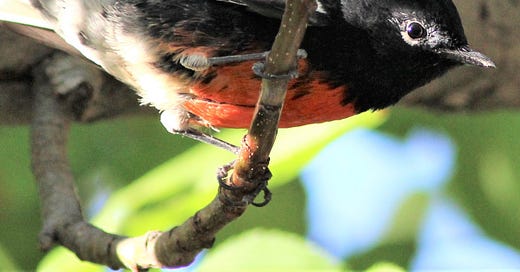Day 7 of the Quarantine (March 20, 2020)
My wife’s travel bag has been slouching on the front porch all week. She dropped it on the worn brick after returning from collecting the Middle Daughter from Phoenix’s Sky Harbor airport and driving her home to Flagstaff. She’s a health educator at Arizona State University, had been in the Dominican Republic since before the outbreak, escorting a group of her students to the city of Jarabacoa and leading medical brigades into low-income neighborhoods for health screenings, which mostly meant dealing with parasites.
“She left all her luggage outside in the sun, too,” my wife told me on her way to the shower. “I’m not taking any chances.”
The Head Blond is wise. As a member of the human race, she understands her “birthright,” as H. G. Wells calls it in The War of the Worlds. A legacy bought by the toll of a billion deaths. But she also knows not to put the Universe to the test.
Today, the first painted redstart arrived from Mexico, flashing black and white and red in the chokecherry tree like a warning beacon. Turkey vultures lean into a dust devil as it lifts the hardpan into the stratosphere. The desert is on the move. My sinuses shrink with the juniper pollen, billowing like yellow smoke on its way to some other corner of the world. I recall my childhood welcome to this dry place, and its name: Valley Fever.
But those dusty fungal spores and their rash and cough and fever were nothing compared to my childhood welcome to the planet: chickenpox, measles, mumps, seasonal flu. It seems that many of my early years were spent in my pajamas isolated from other kids.
Viruses are born to move. To spillover from some reservoir like a population of bats. It’s what they do. A virus trapped in a village won’t get much traction. Viruses either spread or go extinct.
Microbes exist because we are social animals. But what a boon for them when we as their host figured out how to domesticate animals, like camels and oxen and horses, and then attach them to another brainstorm called the wheel. We must have had an infection of the prefrontal cortex with the building and sailing of ocean-crossing vessels. That fever spreading to the creation of the steam and then the internal combustion engines.
In Guns, Germs, and Steel, Jared Diamond writes that we are naturally disposed to think about diseases just from our own point of view. But there’s another way to look at this. “After all,” he says, “microbes are as much a product of natural selection as we are.” From their perspective, we humans have evolved to contain everything they need. From their perspective, they lug us around. We are little more than the bug’s watery travel luggage.
That Nature gave us our big brains to serve the planet’s germs becomes clear when you trace the rise of the current pandemic back to our invention of the turbojet engine.





